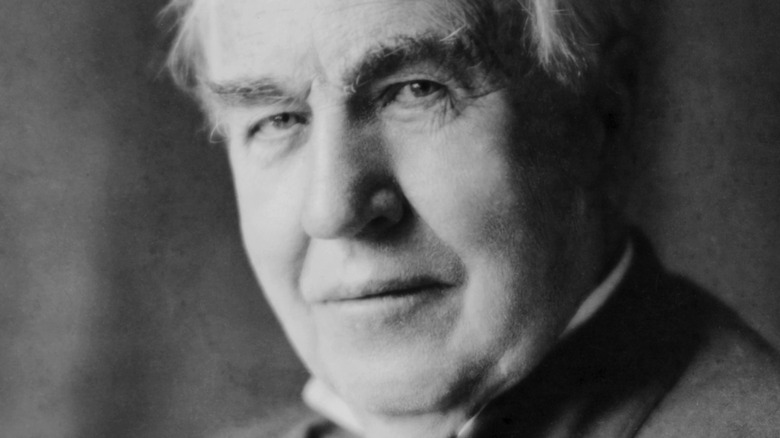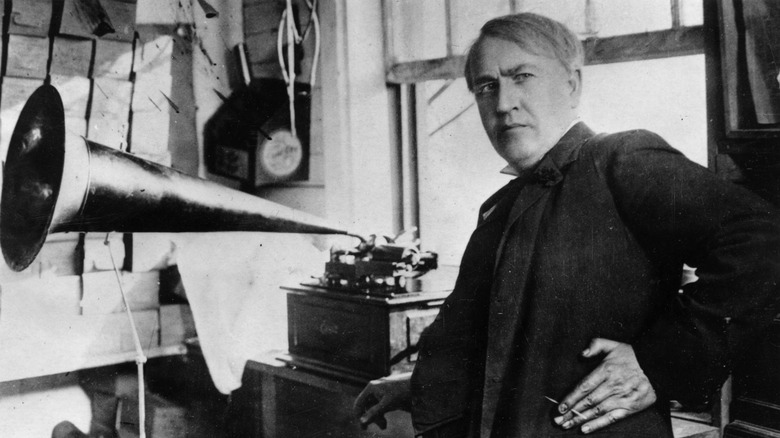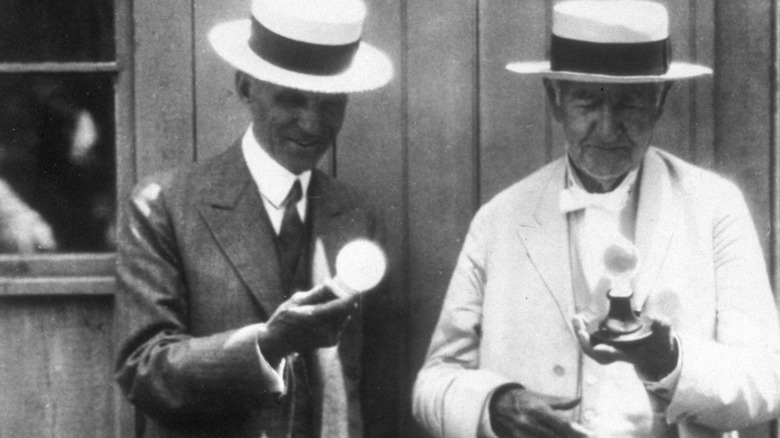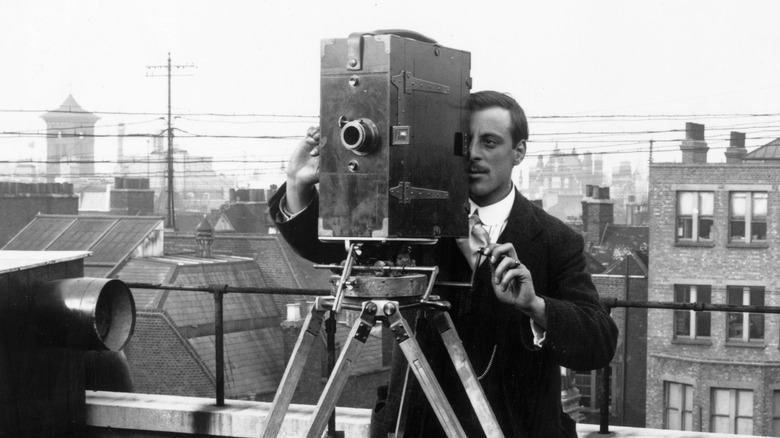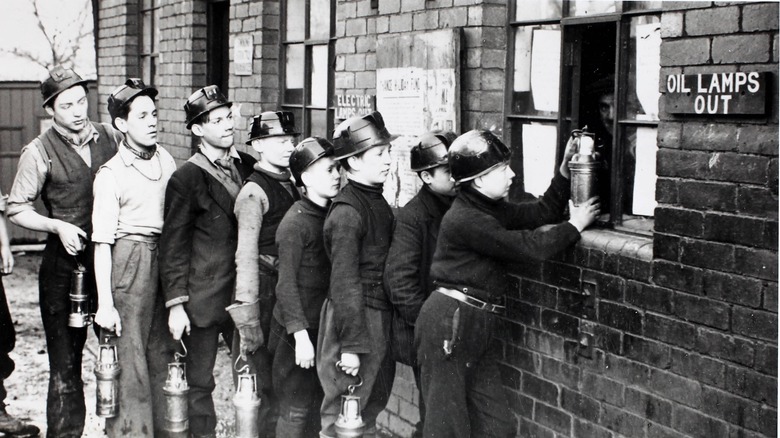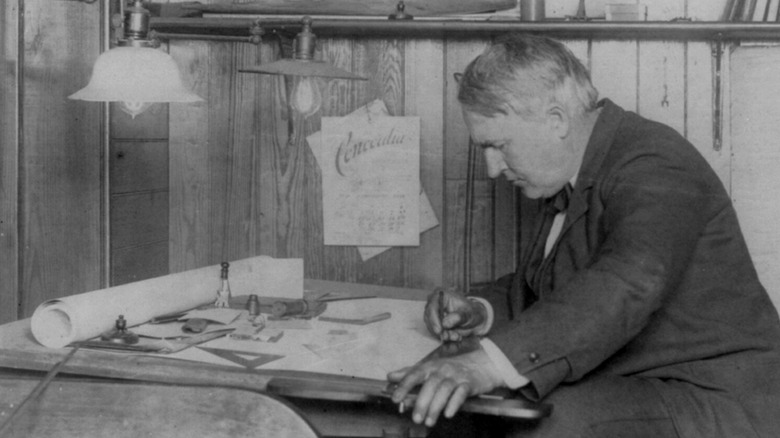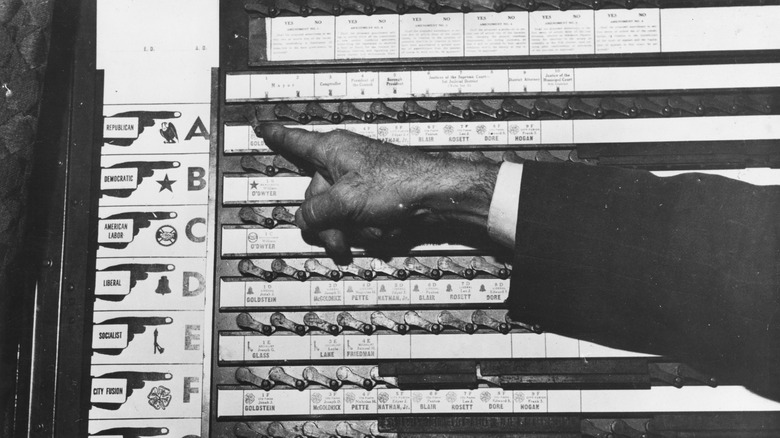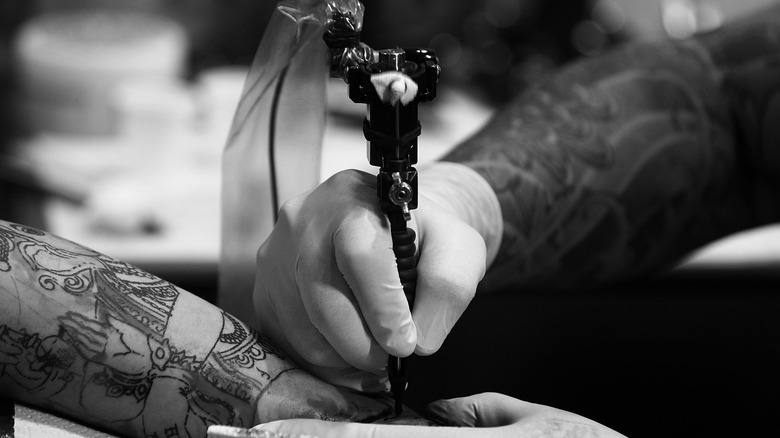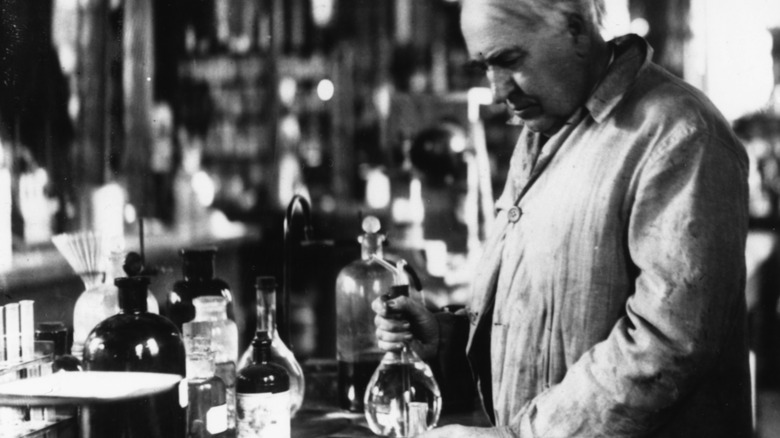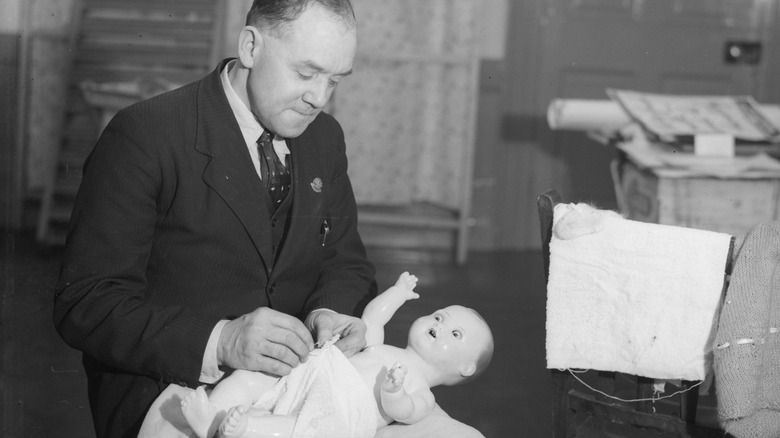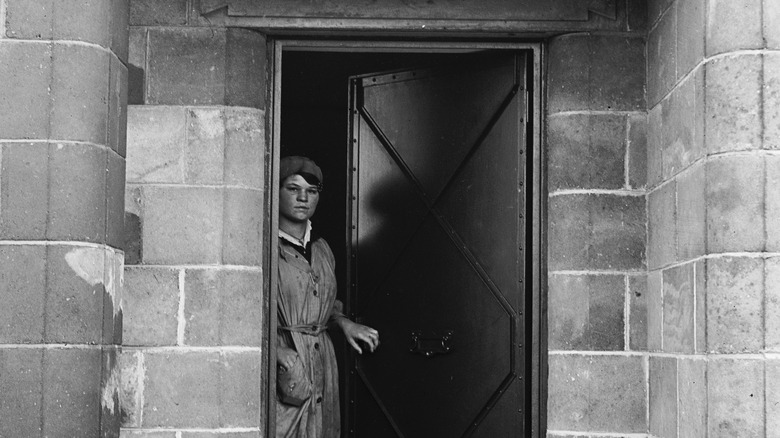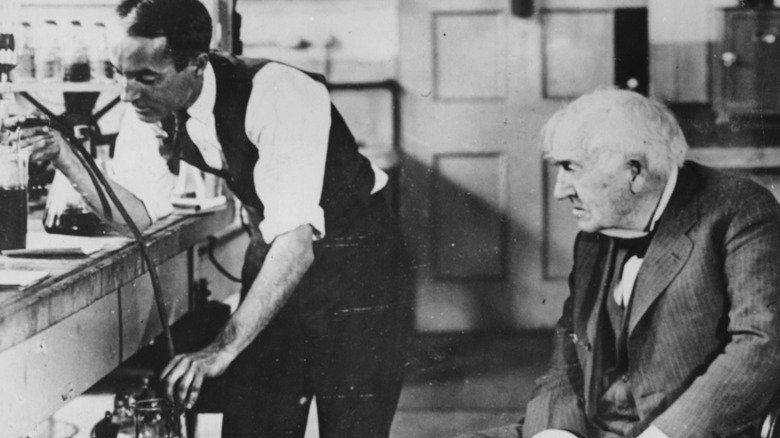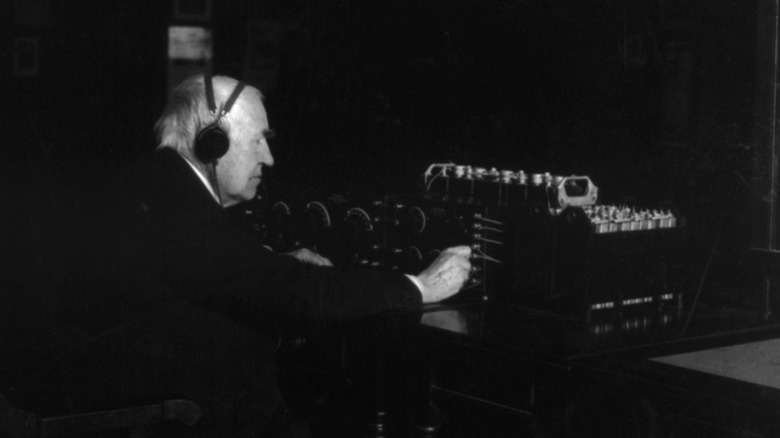11 Best Thomas Edison Inventions
Thomas Edison is probably America's most famous inventor. He is most known for making the first commercially accessible incandescent lightbulb, but overall he had his name on over 1,000 patents. As a child, Edison was easily distracted, so his mother unenrolled him from school and started teaching him at home, according to Biography. By the time he was 11 years old, it was obvious that he loved learning and was able to seek knowledge on his own without the need for a formal education.
By his early 20s, Edison had created several inventions, including a vote recorder and an improved stock ticker. He went on to open a laboratory in New Jersey to research and create even more projects with the help of many assistants. When he got older, Edison spent less time on inventions and more time as an industrialist and businessman. Still, it's his work as an inventor that has left its biggest mark in America, and many of the items we enjoy today were either invented by Edison or improved upon because of his ingenuity. Check out some of the best Thomas Edison inventions below.
Phonograph
Thomas Edison's work on the phonograph was an extension of his work on the telegraph and telephone. His idea was to record a message by using a machine in which sound vibrations would indent a metal cylinder in a groove pattern, according to the Library of Congress. The inventor made a sketch, and his assistant, John Kruesi, reportedly built the machine in just over one day. Edison tested the device by saying nursery rhyme "Mary had a Little Lamb" into the mouthpiece, and the machine repeated his words.
This invention was created sometime between August and December 1877, but most likely towards the end of the year. Edison received a patent for the phonograph on Feb. 19,1878. This particular invention was more original than some of his others. Only one other person had a similar idea, a French scientist named Charley Cros. However, they were not the same machine, and Cros never made a working model of his device. Edison's machine was immensely popular; however, it was a challenge to operate, and the tin foil in the cylinder only worked a few times before it needed to be replaced. The machine was later improved by Alexander Graham Bell, who used waxed paper instead of tin foil, for example. Bell's modernized phonograph was dubbed the graphophone in 1886.
Incandescent light
Contrary to popular belief, a man named Humphry Davy, not Thomas Edison, invented the first electric light in 1802, according to Bulbs.com. Other inventors experimented with lightbulbs for decades, but none of their designs were good for commercial use. That changed when Edison created what is now considered the first practical incandescent light. Between 1878 and 1880, he and his colleagues considered thousands of different ways to produce an efficient incandescent lamp, according to the Franklin Institute. This type of lamp uses electricity to heat a piece of material known as a filament, which glows and becomes a source of light.
Other inventors had worked on incandescent lamps too; however, the light was too powerful and bright for the rooms of an average home. Edison stored the filament in a glass vacuum bulb with the goal of using less electrical power. At first, his lamp only burned for a short period of time. Eventually, he used a carbonized cotton thread filament, and the filament lasted for nearly 15 hours before burning out. The lightbulbs people use today still resemble the one Edison received a patent for in 1880.
Kinetograph
Thomas Edison was inspired to build his movie camera, known as the kinetograph, after examining the work of other inventors, something he did with many of his inventions, according to History. Edward Muybridge and Etienne-Jules Marey had already started working on making motion pictures when Edison decided to use celluloid film in his version of the machine. In May 1893, he demonstrated his first film that depicted three of his associates pretending to be blacksmiths. At the time, other inventors, including Louis and Auguste Lumiere, were also working on making similar devices.
These early films were short in length because Edison and others didn't believe people would want to watch a motion picture longer than 10 minutes. Only one person at a time could view the footage on Edison's kinetograph, according to America's Library. Edison had left the development of his kinetograph to his assistant, W.L.K. Dickson, who left his boss's company in 1895 and founded the startup Biograph Pictures. Three years later, Edison sued American Mutoscope and Biograph Pictures for copyright infringement. In 1902, a court ruled that Edison did not own the copyright to a motion picture camera as a whole.
Cap Lamp
Coal mining was big business during the early 20th century, but it wasn't the safest industry for workers. In 1909, there were 20 coal mine-related disasters, the most that had ever been recorded, according to the National Museum of American History. Two years prior, 362 coal miners died at the Monongah Coal mine in West Virginia, so it spurred Congress to create the U.S. Bureau of Mines in order to do something about working conditions in the industry. As part of the reform, Thomas Edison was asked to invent a safe electric lamp that the miners could wear on their heads.
By 1914, electricity was available in homes, but electric lighting in mines was a much costlier application. Edison wound up creating a rechargeable battery pack, and his invention was known as the Edison Cap Lamp. Miners wore the battery on their belts, and a flexible cord attached to the lamp on the cap. The lamp lasted for 12 hours and was recharged after the miner finished his shift. It would automatically turn off if the bulb broke, for safety purposes.
Fuel cell
Fuel cell technology may sound like a modern concept, but Thomas Edison was working on the idea in the late 19th century, according to Rutgers. In 1882, he filed U.S. Patent 460,122, which involved converting coal into electricity. The goal was to create a current by way of oxidizing a carbon electrode. Edison spent a few years developing what was basically fuel cell technology.
In 1884, he used anthracite coal to achieve a strong current; unfortunately, it was so strong that it blew out the windows in his laboratory. This was one reason why he eventually abandoned work on the project. But he believed there was more work to be done, even if he wasn't the person to do it, revealing in an interview: "There is an opening in the barrier somewhere, and some lucky man will find it. I have got far enough to know that the thing is possible." In 1885, he predicted that producing cheap electricity would result in a "marvelous revolution."
A fuel cell converts chemical energy to electrical energy, according to National Geographic. Someday, fuel cells may power vehicles by way of hydrogen instead of petroleum. Stationary fuel cells are used to power large facilities, such as hospitals and schools. One benefit is that they don't produce as much greenhouse gases or other pollutants. Unfortunately, the technology is expensive, so it's not currently in widespread use.
Electric vote recorder
In 1869, when he was 22 years old, Thomas Edison was working as a telegraph operator. Fortunately for America, he was fired from the position. Had he not been let go from his job, he may not have built his first patented invention: the electric vote recorder. It used a switch and electric current to record ballots, according to Rutgers. After a person selected "yes" or "no," the current would travel to a clerk's desk. The clerk would roll a metal roller over a chemically treated piece of paper and would be able to tabulate the votes.
The goal was to create a simple and quick way to vote that didn't require roll call voting and would cut down on filibustering, which enabled legislators to persuade people to change their votes. One of Edison's colleagues took the invention to Washington, D.C., but Congress did not want to use a machine that fast tracked the voting process. Roll-call voting continued until 1881 when a voting machine invented by Anthony Beranek was allowed for use in general elections, according to the United States Patent and Trademark Office. What happened to Edison's invention? It was never used. Still, his subsequent inventions made him a superstar in America.
Electric pen
Thomas Edison applied for a patent on an electric pen on March 13, 1875. The device was a combination of a dentist's drill and a sewing machine, according to IEEE Spectrum. It featured a motor and two batteries with a needle that made 50 punctures per second. The idea was to improve autographic printing because it could duplicate documents quickly. The pen was poised to be a commercial success as it could be used for a variety of purposes, including copying invoices, labels, contracts, etc. But it never really caught on with the general public.
However, its invention inspired a tattoo artist named Samuel F. O'Reilly, who in 1891 received a patent for an electric tattooing machine that used five needles, a tubular handle, and an ink reservoir to make quick and precise tattoos in a less painful manner. After using Edison's electric pen, O'Reilly invented a device that was stronger and able to penetrate skin. Today, modern tattoo machines bear a striking resemblance to Edison's invention, even though Edison's pen was designed to duplicate documents, while today's tattoo devices are used by people seeking original designs for their body art.
Research laboratory
Up until 1875, Thomas Edison rented spaces in buildings in Newark, New Jersey, where he set up his laboratories. Then he moved to Menlo Park, 12 miles south of the city, to set up a permanent lab in a two-story building, according to Rutgers. He put a machine shop on the first floor and a chemical laboratory on the second floor. It was considered a state-of-the-art laboratory at the time, and something never before seen in the United States. The building was dedicated to scientific research, and Edison claimed he would make minor inventions every 10 days and big ones approximately twice a year.
It became a model for subsequent R&D labs in America. Edison spent the first year at his lab working on telegraph and telephone technology for Western Union. He then produced a carbon-button transmitter and tinfoil phonograph. By 1878, 25 men were working in his lab, and at its peak in 1880 between 50 and 60 men worked at Menlo Park. The facility and staff enabled him to get ahead of other inventors at the time. He was able to build, test, and alter inventions quicker and more efficiently. Plus, he could work on several projects at once.
Talking doll
They were considered extremely creepy at the time, but Thomas Edison produced some of the first talking dolls in 1890, according to NPR. The dolls were about 2-feet tall with metal bodies and wooden arms and legs. Edison produced around 500 dolls, and one reason why they sounded a little strange was because female factory workers imitated children to supply the dialogue. Even Edison wasn't happy with the audio. Their eerie voices, high price tag ($200 today), and inability to move their mouths made them a failure on the commercial market.
One month after he released them, Edison discontinued their production. He called them his "little monsters." This invention is notable because it was a major failure for a man who is known for his incredibly successful inventions. However, he made the dolls in order to showcase his phonograph's entertainment potential, according to the Smithsonian, which makes them pretty special. They spoke several rhymes, including "Mary Had a Little Lamb," "Jack and Jill" and "Hickory Dickory Dock." The talking doll was also a notable invention because it was the first time people, in this case young women, were hired to act as recording artists. Few are still around today.
Concrete home
In 1899, Thomas Edison started the Portland Cement Company. It was innovative in its applications, but it struggled financially. It ended up shutting down in the 1920s despite having supplied concrete for Yankee Stadium, according to Atlas Obscura. But before it went bankrupt, Edison decided to use concrete for a unique purpose: building homes. He filed a patent in 1917 to create a single-molded structure with cement roofs, bathtubs, floors, etc. The goal was to create a fireproof, easy-to-clean, and affordable home. The inventor thought this invention would also alleviate housing shortages.
Unfortunately, building the homes was not cost-effective. Builders needed to invest at least $175,000 in equipment alone. In addition, Americans saw concrete homes essentially as low-income houses and not the elegant and desirable dwellings that Edison advertised them to be. Some concrete homes were constructed in New Jersey and still exist today. Edison also made some concrete furniture, such as cabinets and bedroom sets. But his concrete homes and furnishings never caught on, and his company lost millions. However, he was onto something because these days affordable 3D-printed houses are starting to make waves. They are stronger, quicker to make, and more affordable than traditional homes, according to the Seattle Times.
Storage battery
In the early 1900s, Thomas Edison created a nickel-iron battery for use in electric automobiles. It charged more quickly than lead-acid batteries and was more resilient. Unfortunately, it was also large, more expensive, and released hydrogen while it charged, which was considered potentially dangerous, according to the BBC. Before Edison had the chance to improve his invention, vehicles powered by fossil fuels overtook electric vehicles.
These days, engineers are reexamining the benefits of nickel-iron batteries. It's considered a form of renewable energy along the lines of wind and solar power. While hydrogen used to be considered an undesirable element, it's now seen as a positive part of this type of battery. Researchers in the Netherlands have determined that nickel-iron batteries are more durable and energy efficient than other types of batteries.
According to John Barton, a research associate at the School of Mechanical, Electrical and Manufacturing Engineering, "[Nickel-iron batteries] are resilient, being able to withstand undercharging and overcharging better than other batteries." They are also low maintenance, and the metals used to make them are more common than conventional batteries. When it comes to using them for renewable energy, this could make them more profitable than conventional batteries as well.
Telephone greeting
When Americans answer the phone, typically the first thing they say is "hello." It's also a common phrase to use when being introduced to people for the first time in person. Believe it or not, the word has only been around for two centuries, according to NPR. And Thomas Edison brought it into vogue. When people first started saying "hello," it was often used to attract someone's attention or to express surprise. Then the telephone was invented. Edison encouraged people to say "hello" when answering the phone.
In contrast, Alexander Graham Bell thought people should say "ahoy." The term had been in circulation for over a century, and despite its nautical routes it was a legitimate greeting. At the time, Edison believed the telephone would be used for business reasons only with open line parties on both ends. But there needed to be a way to figure out how to contact the other party to let them know they wanted to speak. Edison explained it to a friend, writing in a letter, "I don't think we shall need a call bell as Hello! can be heard 10 to 20 feet away. What do you think?" reports the New York Times.
